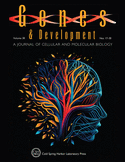NEAT1 promotes genome stability via m6A methylation-dependent regulation of CHD4
- Victoria Mamontova1,2,
- Barbara Trifault1,2,
- Anne-Sophie Gribling-Burrer3,
- Patrick Bohn3,
- Lea Boten1,2,
- Pit Preckwinkel4,
- Peter Gallant2,
- Daniel Solvie2,
- Carsten P. Ade2,
- Dimitrios Papadopoulos2,
- Martin Eilers2,
- Tony Gutschner4,
- Redmond P. Smyth3 and
- Kaspar Burger1,2
- 1Mildred Scheel Early Career Center for Cancer Research (Mildred-Scheel-Nachwuchszentrum [MSNZ]) Würzburg, University Hospital Würzburg, 97080 Würzburg, Germany;
- 2Department of Biochemistry and Molecular Biology, Biocenter of the University of Würzburg, 97074 Würzburg, Germany;
- 3Helmholtz Institute for RNA-Based Infection Research, Helmholtz-Center for Infection Research, 97808 Würzburg, Germany;
- 4Department of RNA Biology and Pathogenesis, Institute of Molecular Medicine, Martin Luther University Halle-Wittenberg, Charles Tanford Protein Research Center, 06120 Halle, Germany
- Corresponding author: kaspar.burger{at}uni-wuerzburg.de
Abstract
Long noncoding (lnc)RNAs emerge as regulators of genome stability. The nuclear-enriched abundant transcript 1 (NEAT1) is overexpressed in many tumors and is responsive to genotoxic stress. However, the mechanism that links NEAT1 to DNA damage response (DDR) is unclear. Here, we investigate the expression, modification, localization, and structure of NEAT1 in response to DNA double-strand breaks (DSBs). DNA damage increases the levels and N6-methyladenosine (m6A) marks on NEAT1, which promotes alterations in NEAT1 structure, accumulation of hypermethylated NEAT1 at promoter-associated DSBs, and DSB signaling. The depletion of NEAT1 impairs DSB focus formation and elevates DNA damage. The genome-protective role of NEAT1 is mediated by the RNA methyltransferase 3 (METTL3) and involves the release of the chromodomain helicase DNA binding protein 4 (CHD4) from NEAT1 to fine-tune histone acetylation at DSBs. Our data suggest a direct role for NEAT1 in DDR.
Keywords
Footnotes
-
Supplemental material is available for this article.
-
Article published online ahead of print. Article and publication date are online at http://www.genesdev.org/cgi/doi/10.1101/gad.351913.124.
-
Freely available online through the Genes & Development Open Access option.
- Received May 10, 2024.
- Accepted September 13, 2024.
This article, published in Genes & Development, is available under a Creative Commons License (Attribution-NonCommercial 4.0 International), as described at http://creativecommons.org/licenses/by-nc/4.0/.










